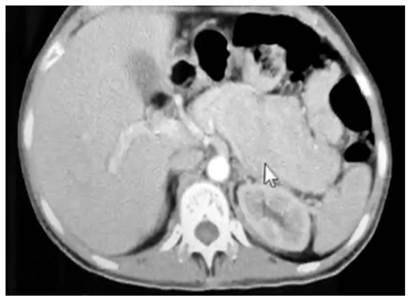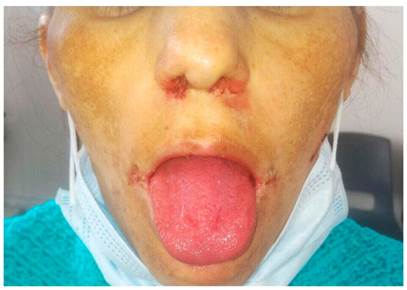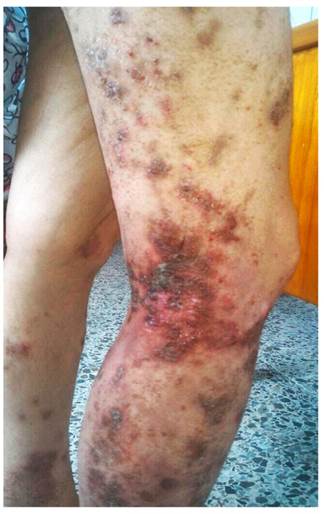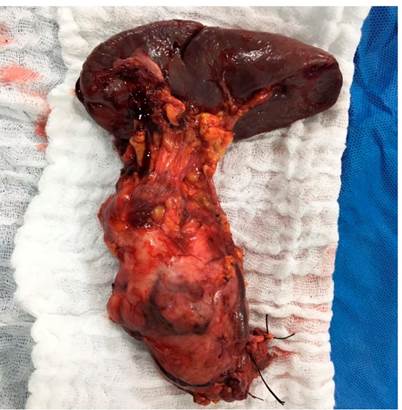Services on Demand
Journal
Article
Indicators
-
 Cited by SciELO
Cited by SciELO -
 Access statistics
Access statistics
Related links
-
 Cited by Google
Cited by Google -
 Similars in
SciELO
Similars in
SciELO -
 Similars in Google
Similars in Google
Share
Revista colombiana de Gastroenterología
Print version ISSN 0120-9957
Rev Col Gastroenterol vol.35 no.3 Bogotá July/Sept. 2020 Epub Mar 01, 2021
https://doi.org/10.22516/25007440.403
Case report
Pancreatic glucagonoma: observing the skin can lead to diagnosis
1Médico internista y gastroenterólogo, Unidad de Gastroenterología y Ecoendoscopia (UGEC), Hospital Universitario Nacional. Profesor asociado de Medicina, Universidad Nacional de Colombia; Bogotá, Colombia
2Médico cirujano hepatobiliar, Hospital Occidente de Kennedy; Bogotá, Colombia.
3Médica dermatóloga, Universidad Militar Nueva Granada. Dermatóloga del Dispensario Médico Gilberto Echeverry Mejía; Bogotá, Colombia
This is a case report of a patient with a pancreatic tumor, known as glucagonoma, whose diagnosis was suspected because of skin manifestations which led to performing a CT scan, finding the mass. She underwent surgery with satisfactory results.
Keywords: Glucagonoma; Pancreatic tumor; Necrolytic migratory erythema
Presentamos el caso de una paciente que tenía un tumor del páncreas -denominado glucagonoma- y cuyo diagnóstico se sospechó por las manifestaciones cutáneas, las cuales nos condujeron realizar una tomografía axial computarizada (TAC). En ella se halló una masa. La paciente se remitió a cirugía y presentó una buena evolución.
Palabras clave: Glucagonoma; tumores del páncreas; eritema necrolítico migratorio
Introduction
Glucagonomas are extremely rare tumors, with an incidence of 1 case per 1 million people. Usually, these tumors are large (>3 cm) and are located mainly in the tail or body of the pancreas due to the high prevalence of α-cells in this area. More than 50%of these tumors are metastatic at the time of diagnosis 1.
The incidence of glucagonoma in men and women is similar and most patients develop them between the fifth and sixth decade of their lives. A particular characteristic of these tumors is that they are associated with skin lesions known as erythema necrolytica migrans. These lesions can lead to the suspicion of glucagonoma as its first manifestation. Patients may also have diabetes, weight loss, deep vein thrombosis (DVT) and abdominal pain 2.
Objective
To present the clinical manifestations of a patient with glucagonoma and describe how the diagnosis was achieved.
Materials and methods
This is the case of a 58-year-old female patient with atrophic glossitis in the central facial region, as well as erythematous crusted plaques in the nasal cavities and angular cheilitis in the labial commissures (Figure 1). Similarly, the patient had crusted erythematous and erythematous-brown plaques on her limbs, presenting with centrifugal growth, in different stages (some active excoriated and others macular with post-inflammatory hyperpigmentation) (Figure 2).
A difference in the diameter of the legs secondary to a deep thrombosis was observed. Subsequently, the patient developed anemia and diabetes. Therefore, multiple studies were performed, but it was not possible to identify the cause of the thrombosis. When the patient started to lose weight, together with abdominal pain, she was referred to our unit. During this period, she only received topical steroids to treat her lesions and oral therapy to manage her diabetes. Then, a CT scan was performed, finding a large mass in the tail of the pancreas (Figure 3), as well as a 2cm liver metastasis. Upon suspicion of a glucagonoma, a plasma glucagon test was performed, reporting elevated levels. For that reason, she was taken to a distal pancreatectomy (Figure 4), which allowed controlling her skin lesions and the diabetes. The pathology report confirmed the existence of the glucagonoma. After a year, the patient was still in cancer treatment (chemotherapy), showing a good response.

Figure 3 The arrow points to a large mass at the tail of the pancreas, which displaces the left kidney.
Glucagonomas were first described in 1942 by Becker et al. These authors reported a case, very similar to once presented here, of a 45-year-old woman with mucocutaneous lesions associated with an altered glucose tolerance test. During the patient’s autopsy, a mass was found in the pancreas 3.
However, it was Dr. McGavran who, in 1966, described the typical symptoms of this condition, which are characterized by the presence of dermatitis associated with elevated glucagon levels, since glicagonomas are neuroendocrine tumors that originate in endodermal pluripotent stem cells and arise from pancreatic islets cells 4-7.
Most glucagonomas are solitary; however, less than 10% of them have been associated with the syndrome of multiple endocrine neoplasia type 1 (MEN1). In our case, this syndrome was ruled out 8.
Conclusion
Glucagonoma is a very rare tumor, which is why it is rarely suspected. The case reported here shows that the skin lesions of the patient could have led to an earlier diagnosis since the necrolytic erythema migration confirmed in the patient’s pathology is typical of the disease. This tumor is associated with DVT, diabetes, anemia and weight loss, which are the five typical characteristics that should lead to suspect the presence of this pancreatic tumor. If detected timely, it has a very good prognosis.
REFERENCES
1. Sarr MG, Murr M, Smyrk TC, Yeo CJ, Fernández-del-Castillo C, Hawes RH, Freeny PC. Primary cystic neoplasms of the pancreas. Neoplastic disorders of emerging importance-current state-of-the-art and unanswered questions. J Gastrointest Surgí. 2003;7(3):417-28. http://doi.org/10.1016/s1091-255x(02)00163-4 [ Links ]
2. Adsay NV. Cystic neoplasia of the pancreas: pathology and biology. J Gastrointest Surg. 2008;12(3):401-404. http://doi.org/10.1007/s11605-007-0348-z [ Links ]
3. Braverman IM. “Cutaneous manifestations of internal malignant tumors” by Becker, Kahn and Rothman, June 1942. Commentary: Migratory necrolytic erythema. Arch Dermatol. 1982;118(10):784-798. http://doi.org/10.1001/archderm.118.10.784 [ Links ]
4. McGavran MH, Unger RH, Recant L, Polk HC, Kilo C, Levin ME. A glucagon-secreting alpha-cell carcinoma of the pancreas. N Engl J Med. 1966;274(25):1408-1413. http://doi.org/10.1056/NEJM196606232742503 [ Links ]
5. Yao JC, Eisner MP, Leary C, Dagohoy C, Phan A, Rashid A, Hassan M, Evans DB. Population-based study of islet cell carcinoma. Ann Surg Oncol. 2007;14(12):3492-500. http://doi.org/10.1245/s10434-007-9566-6 [ Links ]
6. Kindmark H, Sundin A, Granberg D, Dunder K, Skogseid B, Janson ET, Welin S, Oberg K, Eriksson B. Endocrine pancreatic tumors with glucagon hypersecretion: a retrospective study of 23 cases during 20 years. Med Oncol. 2007;24(3):330-7. http://doi.org/10.1007/s12032-007-0011-2 [ Links ]
7. Tierney EP, Badger J. Etiology and pathogenesis of necrolytic migratory erythema: review of the literature. MedGenMed. 2004;6(3):4. [ Links ]
8. van Beek AP, de Haas ER, van Vloten WA, Lips CJ, Roijers JF, Canninga-van Dijk MR. The glucagonoma syndrome and necrolytic migratory erythema: a clinical review. Eur J Endocrinol. 2004;151(5):531-537. http://doi.org/10.1530/eje.0.1510531 [ Links ]
Citation: Gómez MA, Martínez R, Olmos LM. Pancreatic glucagonoma: observing the skin can lead to diagnosis. Rev Colomb Gastroenterol. 2020;35(3):369-371. https://doi.org/10.22516/25007440.403
Received: January 30, 2018; Accepted: August 29, 2018











 text in
text in 






